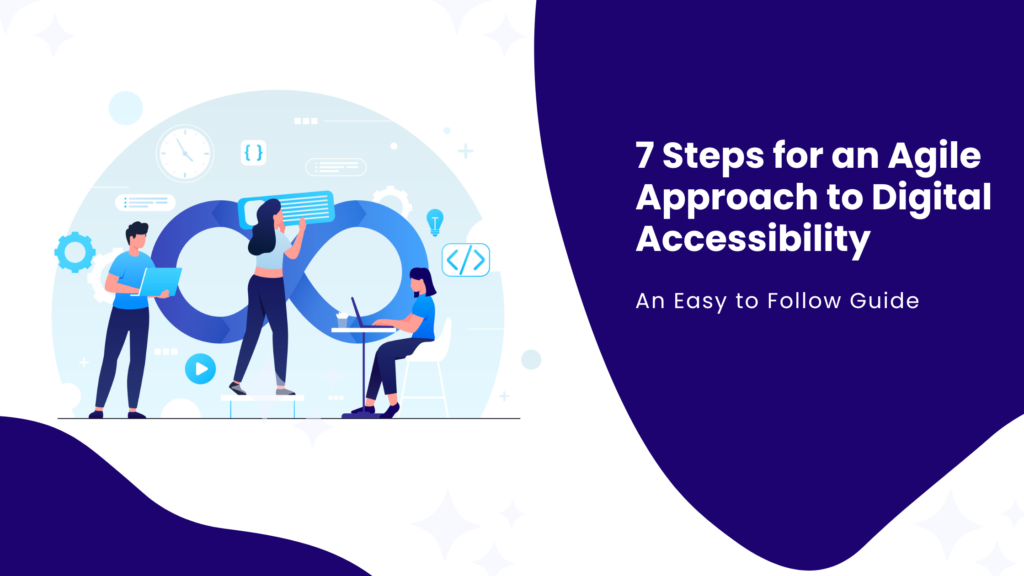Thinking about web accessibility from the start of a development journey is essential for creating inclusive digital experiences. In today’s fast-paced development environment, adopting an agile accessibility approach ensures that accessibility is seamlessly integrated throughout the product development lifecycle, rather than being addressed at the end.
In this guide, we’ll walk you through the key steps to effectively incorporate agile accessibility into your workflow, making it a core part of your development process.
1. Accessibility as a Core Principle
The foundation of an agile accessibility approach is changing the perception of accessibility from being an afterthought to becoming a core principle. Accessibility should be built into the project from the very start, not as a checklist at the end. This requires educating every team member—from designers to developers—about accessibility guidelines, such as WCAG.
At Pivotal Accessibility, we offer accessibility training workshops to ensure your team is fully equipped with the necessary skills and knowledge to develop accessible digital products.
Key Action:
- Educate your team on accessibility guidelines and make accessibility a shared responsibility.
2. Incorporate Accessibility into Agile User Stories
User stories are the backbone of agile development. For agile accessibility, make sure every user story includes accessibility criteria. This will ensure that accessibility is not overlooked during the development process. For example; “As a user with low vision, I need the app to have high-contrast options to easily navigate it.”
Key Action:
- Write user stories with specific accessibility requirements to address diverse user needs.
3. Cross-Functional Collaboration
Agile teams thrive on collaboration. Ensure that all team members—product managers, designers, developers, and testers—work together with a focus on accessibility. This collaboration helps identify and solve accessibility challenges early in the process, making the product more inclusive.
Key Action:
- Schedule regular team discussions on accessibility progress and challenges.
4. Automate Digital Accessibility Testing
Manual testing is essential, but automating accessibility testing ensures that you catch potential issues as early as possible. Tools like Axe, Lighthouse and our own automated Color Contrast Checker extension can be integrated into your continuous integration pipeline to scan for accessibility issues.
Key Action:
- Integrate automated accessibility tests into your agile pipeline to catch issues early.
5. Test with Real Users
Automated testing tools can only go so far. Testing with real users, especially those with disabilities, provides insights that automated tools might miss. This hands-on feedback is critical for understanding how users interact with your product in real-world scenarios.
Key Action:
- Include real users with disabilities in your usability testing sessions to ensure practical accessibility.
6. Manage Accessibility Debt
Like technical debt, accessibility debt builds up when accessibility issues are postponed. Track accessibility challenges in your backlog, prioritize them during sprint planning and continuously address them to reduce the long-term problems.
Key Action:
- Create an accessibility backlog and allocate time to address issues in each sprint.
7. Iterate for Continuous Improvement
Agile thrives on continuous improvement. After each sprint, hold a retrospective to assess how well the team met web accessibility goals and where improvements can be made. Use these insights to refine your approach.
Moreover, accessibility standards evolve, and it’s crucial to stay updated. Make it a habit to keep your team informed of any updates to WCAG guidelines, new tools, or emerging trends in web accessibility.
Key Action:
- Set measurable accessibility goals for each sprint and adjust based on retrospective feedback.
Making Agile Accessibility a Part of Your Workflow
Adopting an agile approach to accessibility improves the inclusivity of your digital products and also enhances user satisfaction, product quality, and legal compliance. By embedding accessibility into your agile process—through user stories, collaboration, automated testing, and real-world feedback—you can create an inclusive experience for all users.
If you’re ready to start your journey toward building more accessible and inclusive digital products, Pivotal Accessibility is here to help. Explore our services and see how we can support your team in creating digital experiences that are accessible to everyone.
Contact us today to learn how we can work together to integrate accessibility into your agile process and take your products to the next level of inclusivity!

